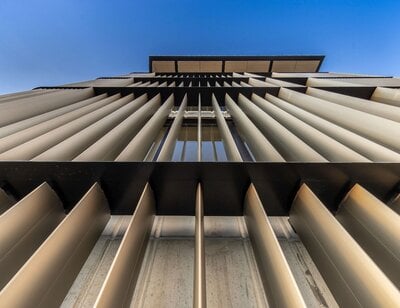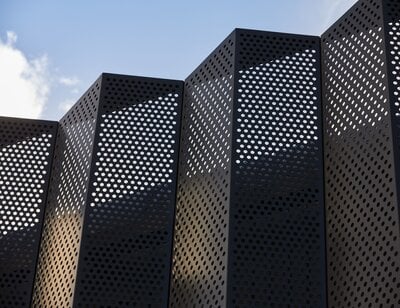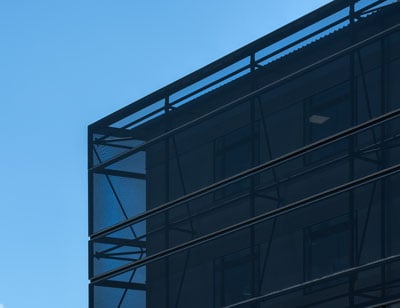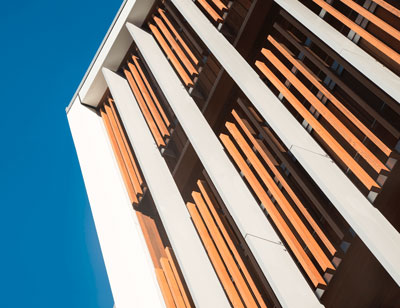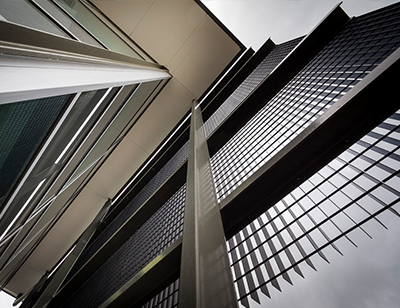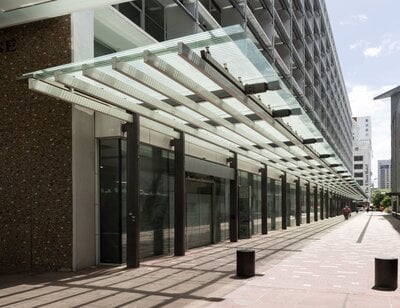“We shape our buildings and then afterwards our buildings shape us”. Those words from Winston Churchill, uttered as he was ruminating over the repair of a bomb ravaged House of Commons in 1943, are well known and understood by many. And now they are backed by science and the era of Neuro Architecture (designing the built environment using principles from neurosciences) of which the building facade is of central importance.
Previous research has long connected the built environment with the mood of its inhabitants. For example, epidemiological studies have shown how people raised in densely populated urban environments are at an elevated risk of mental disorders compared to those from more rural communities. We know Schizophrenia is twice as likely for city-dwellers over country-living counterparts, with the risk increasing in line with a City’s population. Now, thanks to the work of Andreas Meyer-Lindenburg of the University of Heidleberg’s Central Institute of Mental Health (Mannheim, Germany), we know people from the city and countryside respond to social stress differently. Trial subjects in their tests were subjected to ‘social stress’ and only those from the city had an activated amygdala (the part of the brain which processes emotions) and elevated activity in the cingulate cortex (the area which helps regulate the amygdala and processes negative emotions).
We also know geometry and the arrangement of the space around us has an impact on brain activity, engaging specialised cells in the hippocampus region of the brain. This is the same area activated in animals forced to navigate across vast distances with only a cognitive map to lead them to food, shelter and mates.
Building on this knowledge is a growing body of research highlighting the potential cognitive impact of architecture on local inhabitants. At the forefront of thinking and raising awareness of
Neuro Architecture is The Centre for Conscious Design who regularly hold events such as the Conscious Cities Conference in London, which brought together architects, designers, engineers, neuroscientists and psychologists, to discuss how cognitive science might be used to better develop a healthy built environment.
The goal of such cross-discipline conversations is advancing Neuro Architecture and learning how psychology based insights can simultaneously influence inhabitants in a positive way, while avoiding the repeat of failures such as the Pruitt-Igoe housing complex. Built in the 1950’s and demolished just 20 years later, the St Louis complex is a prime example of how design can influence behaviours to the point violence and crime actually increase.
So how do we overcome past mistakes and use design to positively impact behaviours in the built environment? This is where building facades might have the answer. Colin Ellard is a Professor of Cognitive Neuroscience and Director of the Urban Realities Laboratory at the University of Waterloo. His work takes a closer look at the psychological impact of design and the research has consistently found people are strongly affected by building facades.
For example, it shows how walking past the curtain wall facade of a retail store leads to a dramatic decrease in both the arousal and mood of individuals, the subconscious reaction being to hasten the stride to get past the facade. That mood was reversed when the building facade was more intricate and varied, leading to an increase in engagement and feeling of liveliness. The lesson? Interesting and engaging trumps blandness, and not just from a ‘beauty is in the eye of the beholder’ perspective but from one rooted in neuroscience too. And the outcome might just be happier inhabitants.
So what else can influence mood and behaviour? Unsurprisingly, green space is important too. Published in the Lancet in 2008, “Effect of exposure to natural environment on health inequalities: An observational population study” (Dr Richard Mitchell PhD & Dr Frank Popham PhD) details how inequality, which is known to increase the risk of circulatory disease among lower socio-econmic groups, is lessened when individuals reside in ‘greener areas’.
It could be that there is a cause and effect relationship here that mirrors the previously mentioned experiment detailing how moods change when walking past a building facade. The theory is visual complexity, present in both the natural environment and in a more complicated facade (not the curtain wall), acts as some kind of mental salve. This theory is supported by research showing how residential streets with architectural variation are more mentally engaging, which also explains how the ‘build and repeat’ of council estates in poorer regions of England can contribute to poor mental and physical health.
Interestingly, and also largely counterintuitively, loneliness amongst the masses in a City is a major problem, and where building facades are characterless and part of a design aimed at discouraging social interaction, it can add to loneliness, which often leads to ill health. For example, some building facades and street frontages are designed to discourage people from hanging around. This might be through the use of people-repelling spikes or other design features. Whilst they are obviously aimed at discouraging the transient population of a City from the building front, they also have a negative effect on the general mood of the public. Instead, urban spaces might be better placed following the design advice of the late William Whyte and his process of ‘triangulation’, which promotes the use of objects and artefacts to nudge inhabitants closer together if they hope they converse.
Finally, we return to the impact of space and direction. Which possibly means we’ve been talking in circles even though we know that is definitely not desirable. The reason being any sense of disorientation can be a real negative in the built environment, impacting the happiness of inhabitants. For this reason, we’d point to Invercargill as a place to make you happy. Aside from having our headquarters here, the grid-like structure of the CBD makes sense and in doing so, benefits the mood of locals and visitors.
Added to this is the varied nature of many of the buildings. There is no generic and sterile faceless facade of office blocks to walk past, meaning there’s enough visual variety and complexity to foster easy navigation and stimulate the mind.
What the above all points to, apart from the need to come visit Invercargill, is a genuine need for facade variety that supports a Neuro Architectural approach and the science behind it. To that end, aluminium is the perfect facade material as we can shape it into whatever vision the architect wants. And that vision might very well go a long way to bringing smiles to the faces of local residents, helping them live healthier and for longer.
Good architecture is important like that.

